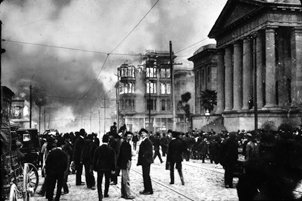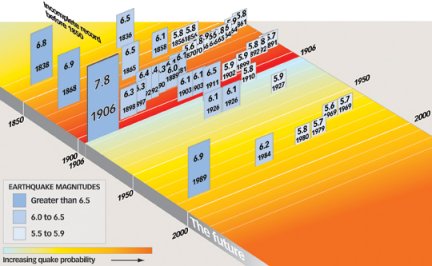A great quake coming?
The 100th anniversary of the great San Francisco earthquake is a reminder that future quakes could cause even more damage.
By Emily Sohn
Everyone who lives in San Francisco knows that earthquakes are common in the Bay Area—and they can be devastating. One hundred years ago this month, for example, a major quake destroyed about 28,000 buildings and killed hundreds, perhaps thousands of people. The ground shook for nearly a minute, and buildings burst into flame. The fires burned for days.
 |
|
After the San Francisco quake of 1906, residents could only stand by as fires, often fueled by broken gas lines, devastated the city. Fractured water mains hampered firefighters, so flames spread for 3 days after the quake.
|
| Virtual Museum of the City of San Francisco (www.sfmuseum.org). |
Residents now wonder when the next “Big One” will strike. It’s bound to happen someday. At least seven active fault lines run through the San Francisco area. Faults are places where pieces of Earth’s crust slide past each other. When these pieces slip, the ground shakes.
To prepare for that day, scientists are using new techniques to reanalyze the 1906 earthquake and predict how bad the damage might be when the next one happens.
One new finding about the 1906 quake is that the San Andreas fault split apart, or ruptured, faster than scientists had assumed at the time. During small earthquakes, faults rupture at about 2.7 kilometers per second. During bigger quakes, however, recent observations show that ruptures can happen at rates faster than 3.5 kilometers per second.
At such high speeds, massive amounts of pressure build up, generating underground (seismic) waves that can cause more damage than the quake itself. Lucky for San Francisco, these pressure pulses traveled away from the city during the 1906 event. As bad as the damage was, it could have been far worse.
Looking ahead, scientists are trying to predict when the next major quake will occur. Records show that earthquakes were common before 1906. Since then, there has been something of a lull. Patterns in the data, however, suggest that the probability of a major earthquake striking the Bay Area before 2032 is at least 62 percent.
 | ||
|
| ||
| U.S. Geological Survey |
New buildings in San Francisco have to follow strict codes that stabilize them against future quakes. Still, more than 84 percent of the city’s buildings are old, weak, and vulnerable. Analyses suggest that another massive earthquake would cause extensive damage.
People who live there today tend to feel safe because San Francisco has remained pretty quiet for a while. According to the new research, however, it’s not a matter of “if” the Big One will hit. It’s just a matter of when.
Going Deeper:
Perkins, Sid. 2006. Region at risk. Science News 169(April 15):234-236. Available at http://www.sciencenews.org/articles/20060415/bob10.asp .
To learn more about the great 1906 San Francisco earthquake, go to quake.wr.usgs.gov/info/1906/ (U.S. Geological Survey) or www.sfmuseum.org/1906/06.html (Virtual Museum of the City of San Francisco).







